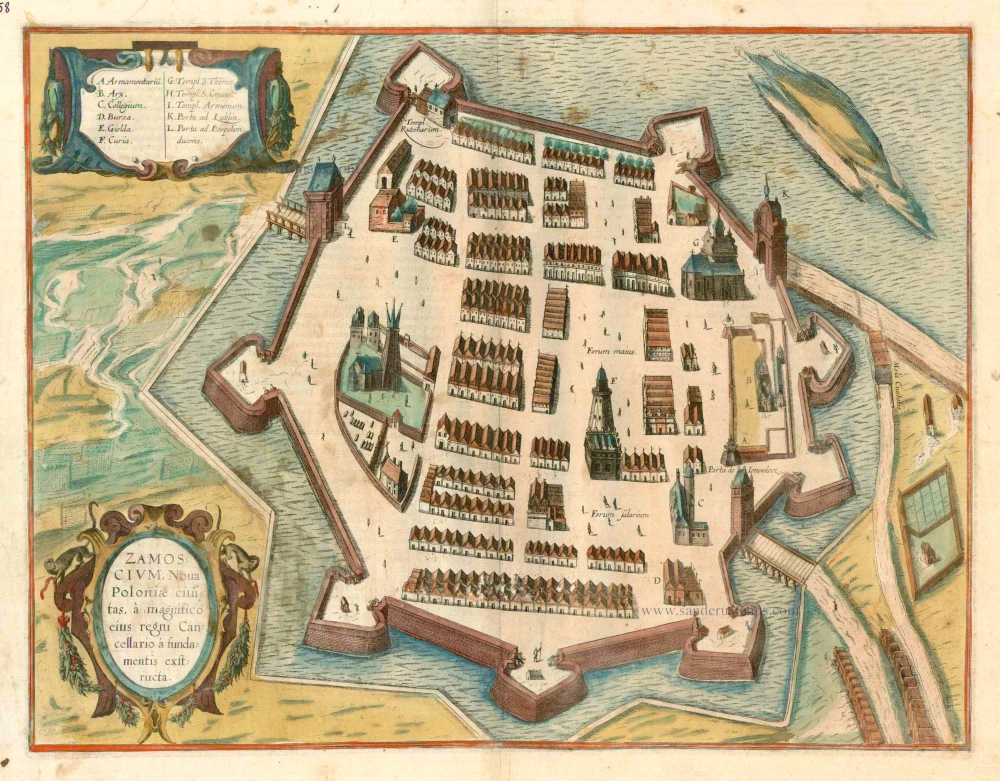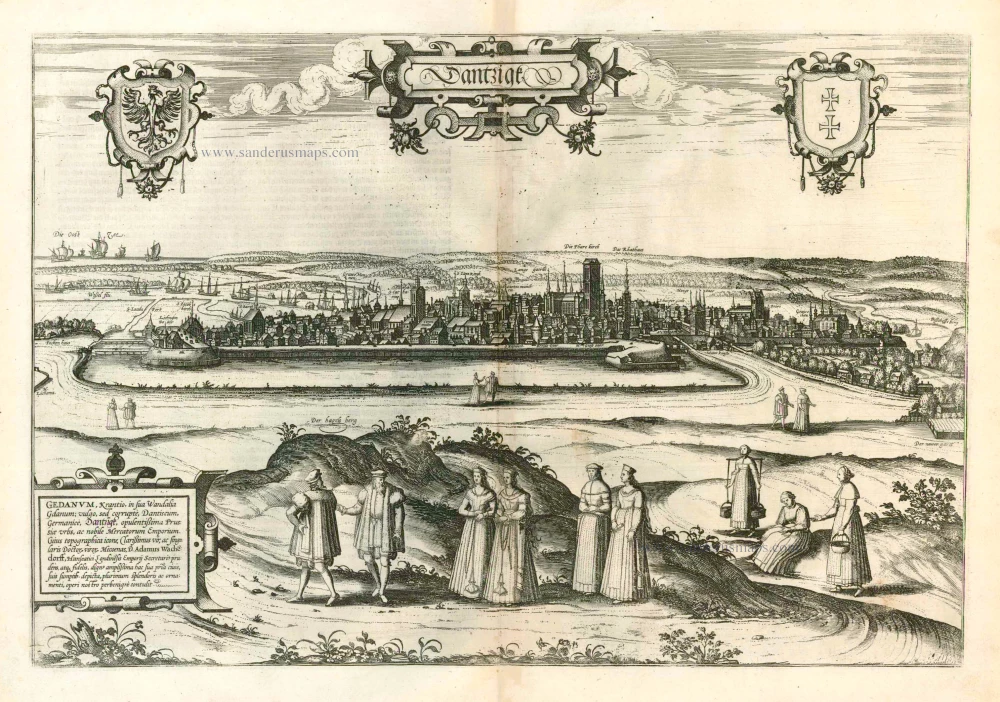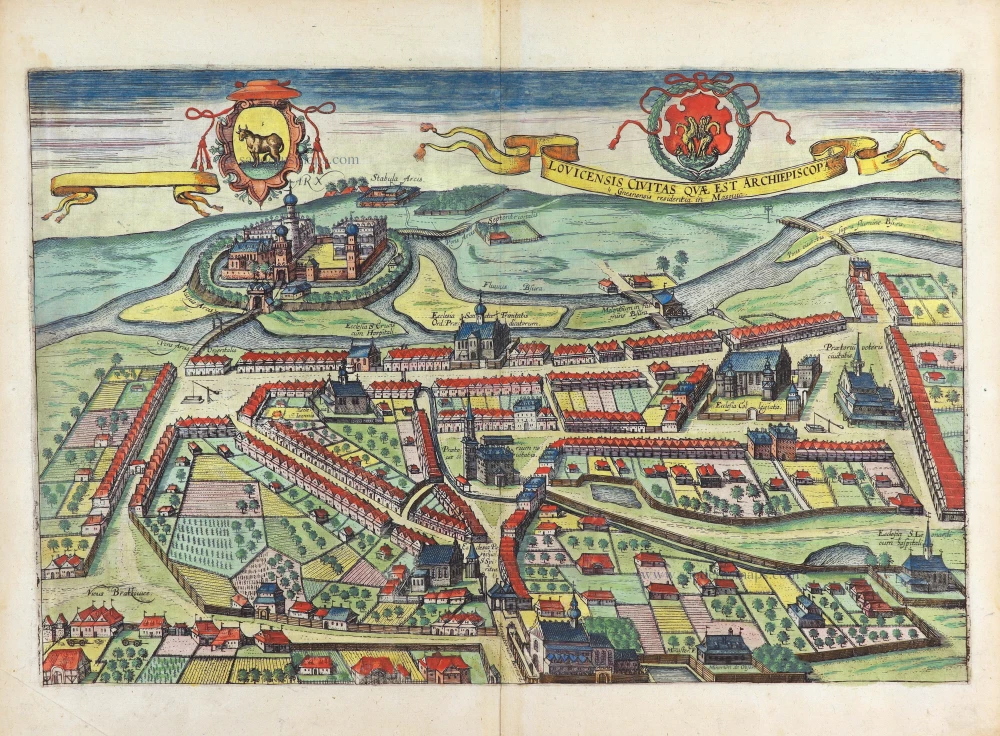Zamosc in Poland, by Georg Braun and Frans Hogenberg. c. 1625
CARTOUCHE BOTTOM: Zamosc, a new city in Poland, was built from the foundation by its great chancellor.
COMMENTARY BY BRAUN (on verso): "After returning from the war, Jan Zamoyski built a new town in a fair plain beside the River Labunka, with a broad and deep moat around it. [...] He set up a splendid academy in his town to satisfy his love of learning. He appointed skilled professors in all possible faculties, such as theology, jurisprudence, medicine, and other liberal arts and languages. [...] And it is hard to find words to describe how this town became filled in the shortest time with people from all over the world, whether Poles, Greeks, Armenians, Spaniards, Germans or Italians, who all settled here, each bringing his craft and practising it here to the advantage and benefit of all."
This plate of Zamosc is an unusually static bird's-eye view with unrealistic proportions. The geometrically laid-out, fortified town in the southeast of Poland is shown here from the north. It was built in the late 16th and early 17th centuries as a total work of art, in the Renaissance manner, by the Italian architect Bernardo Morando and soon became known as the Padua of the North. It was named after its founder, Jan Zamoyski, the Grand Chancellor of Poland, who built it as an ideal city - a centre of culture and learning, an ecclesiastical centre, a residence, a trade centre and a fortress all in one. Right from the start, the city had a humanist academy (C) to train a political elite. Zamosc immediately became a prosperous centre of science, arts and trade. (Taschen)
Braun G. & Hogenberg F. and the Civitates Orbis Terrarum.
The Civitates Orbis Terrarum, also known as the 'Braun & Hogenberg', is a six-volume town atlas and the most excellent book of town views and plans ever published: 363 engravings, sometimes beautifully coloured. It was one of the best-selling works in the last quarter of the 16th century. Georg Braun, a skilled writer, wrote the text accompanying the plans and views on the verso. Many plates were engraved after the original drawings of a professional artist, Joris Hoefnagel (1542-1600). The first volume was published in Latin in 1572 and the sixth in 1617. Frans Hogenberg, a talented engraver, created the tables for volumes I through IV, and Simon van den Neuwel made those for volumes V and VI. Other contributors were cartographers Daniel Freese and Heinrich Rantzau, who provided valuable geographical information. Works by Jacob van Deventer, Sebastian Münster, and Johannes Stumpf were also used as references. Translations appeared in German and French, making the atlas accessible to a broader audience.
Since its original publication of volume 1 in 1572, the Civitates Orbis Terrarum has left an indelible mark on the history of cartography. Seven more editions followed the first volume in 1575, 1577, 1582, 1588, 1593, 1599, and 1612. Vol.2, initially released in 1575, saw subsequent editions in 1597 and 1612. The subsequent volumes, each a treasure trove of historical insights, graced the world in 1581, 1588, 1593, 1599, and 1606. The German translation of the first volume, a testament to its widespread appeal, debuted in 1574, followed by the French edition in 1575.
Several printers were involved: Theodor Graminaeus, Heinrich von Aich, Gottfried von Kempen, Johannis Sinniger, Bertram Buchholtz, and Peter von Brachel, all of whom worked in Cologne.
Georg Braun (1541-1622)
Georg Braun, the author of the text accompanying the plans and views in the Civitates Orbis Terrarum, was born in Cologne in 1541. After his studies in Cologne, he entered the Jesuit Order as a novice, indicating his commitment to learning and intellectual pursuits. In 1561, he obtained his bachelor's degree; in 1562, he received his Magister Artium, further demonstrating his academic achievements. Although he left the Jesuit Order, he continued his studies in theology, gaining a licentiate in theology. His theological background likely influenced the content and tone of the text in the Civitates Orbis Terrarum, adding a unique perspective to the work.
Frans Hogenberg (1535-1590)
Frans Hogenberg was a Flemish and German painter, engraver, and mapmaker. He was born in Mechelen as the son of Nicolaas Hogenberg.
By the end of the 1560s, Frans Hogenberg was employed upon Abraham Ortelius's Theatrum Orbis Terrarum, published in 1570; he is named an engraver of numerous maps. In 1568, he was banned from Antwerp by the Duke of Alva and travelled to London, where he stayed a few years before emigrating to Cologne. He immediately embarked on his two most important works, the Civitates, published in 1572 and the Geschichtsblätter, which appeared in several series from 1569 until about 1587.
Thanks to large-scale projects like the Geschichtsblätter and the Civitates, Hogenberg's social circumstances improved with each passing year. He died as a wealthy man in Cologne in 1590.
Zamoscium. Nova Poloniae civitas, à magnifico eius regni Cancellaro à fundamentis exstructa.
Item Number: 16505 Authenticity Guarantee
Category: Antique maps > Europe > Eastern Europe
Antique map - Bird's-eye view of Zamosc in Poland, by Braun and Hogenberg. Key to 11 locations.
Date of the first edition: 1617
Date of this map: c. 1625
Copper engraving
Size: 35.5 x 46cm (13.8 x 17.9 inches)
Verso text: French
Condition: Contemporary coloured, stained.
Condition Rating: B
References: Van der Krogt 4, 4914, State 1 (without imprint); Taschen, Braun and Hogenberg, p. 486
From: Théatre des Principales Villes de tout l'Univers Vol. VI. c. 1625. (Van der Krogt 4, 41:3.6)
CARTOUCHE BOTTOM: Zamosc, a new city in Poland, was built from the foundation by its great chancellor.
COMMENTARY BY BRAUN (on verso): "After returning from the war, Jan Zamoyski built a new town in a fair plain beside the River Labunka, with a broad and deep moat around it. [...] He set up a splendid academy in his town to satisfy his love of learning. He appointed skilled professors in all possible faculties, such as theology, jurisprudence, medicine, and other liberal arts and languages. [...] And it is hard to find words to describe how this town became filled in the shortest time with people from all over the world, whether Poles, Greeks, Armenians, Spaniards, Germans or Italians, who all settled here, each bringing his craft and practising it here to the advantage and benefit of all."
This plate of Zamosc is an unusually static bird's-eye view with unrealistic proportions. The geometrically laid-out, fortified town in the southeast of Poland is shown here from the north. It was built in the late 16th and early 17th centuries as a total work of art, in the Renaissance manner, by the Italian architect Bernardo Morando and soon became known as the Padua of the North. It was named after its founder, Jan Zamoyski, the Grand Chancellor of Poland, who built it as an ideal city - a centre of culture and learning, an ecclesiastical centre, a residence, a trade centre and a fortress all in one. Right from the start, the city had a humanist academy (C) to train a political elite. Zamosc immediately became a prosperous centre of science, arts and trade. (Taschen)
Braun G. & Hogenberg F. and the Civitates Orbis Terrarum.
The Civitates Orbis Terrarum, also known as the 'Braun & Hogenberg', is a six-volume town atlas and the most excellent book of town views and plans ever published: 363 engravings, sometimes beautifully coloured. It was one of the best-selling works in the last quarter of the 16th century. Georg Braun, a skilled writer, wrote the text accompanying the plans and views on the verso. Many plates were engraved after the original drawings of a professional artist, Joris Hoefnagel (1542-1600). The first volume was published in Latin in 1572 and the sixth in 1617. Frans Hogenberg, a talented engraver, created the tables for volumes I through IV, and Simon van den Neuwel made those for volumes V and VI. Other contributors were cartographers Daniel Freese and Heinrich Rantzau, who provided valuable geographical information. Works by Jacob van Deventer, Sebastian Münster, and Johannes Stumpf were also used as references. Translations appeared in German and French, making the atlas accessible to a broader audience.
Since its original publication of volume 1 in 1572, the Civitates Orbis Terrarum has left an indelible mark on the history of cartography. Seven more editions followed the first volume in 1575, 1577, 1582, 1588, 1593, 1599, and 1612. Vol.2, initially released in 1575, saw subsequent editions in 1597 and 1612. The subsequent volumes, each a treasure trove of historical insights, graced the world in 1581, 1588, 1593, 1599, and 1606. The German translation of the first volume, a testament to its widespread appeal, debuted in 1574, followed by the French edition in 1575.
Several printers were involved: Theodor Graminaeus, Heinrich von Aich, Gottfried von Kempen, Johannis Sinniger, Bertram Buchholtz, and Peter von Brachel, all of whom worked in Cologne.
Georg Braun (1541-1622)
Georg Braun, the author of the text accompanying the plans and views in the Civitates Orbis Terrarum, was born in Cologne in 1541. After his studies in Cologne, he entered the Jesuit Order as a novice, indicating his commitment to learning and intellectual pursuits. In 1561, he obtained his bachelor's degree; in 1562, he received his Magister Artium, further demonstrating his academic achievements. Although he left the Jesuit Order, he continued his studies in theology, gaining a licentiate in theology. His theological background likely influenced the content and tone of the text in the Civitates Orbis Terrarum, adding a unique perspective to the work.
Frans Hogenberg (1535-1590)
Frans Hogenberg was a Flemish and German painter, engraver, and mapmaker. He was born in Mechelen as the son of Nicolaas Hogenberg.
By the end of the 1560s, Frans Hogenberg was employed upon Abraham Ortelius's Theatrum Orbis Terrarum, published in 1570; he is named an engraver of numerous maps. In 1568, he was banned from Antwerp by the Duke of Alva and travelled to London, where he stayed a few years before emigrating to Cologne. He immediately embarked on his two most important works, the Civitates, published in 1572 and the Geschichtsblätter, which appeared in several series from 1569 until about 1587.
Thanks to large-scale projects like the Geschichtsblätter and the Civitates, Hogenberg's social circumstances improved with each passing year. He died as a wealthy man in Cologne in 1590.






